I know that for olympic recurve shooters they choose their front stabilizer lengths to be close to their draw length. Is that the same for target compound shooters? I'm struggling to find any explanation on the internet

How do target compound shooters choose front stabilizer length?
GarrettNotAvailable
1 - 20 of 36 Posts
Joined
·
120 Posts
I know that for olympic recurve shooters they choose their front stabilizer lengths to be close to their draw length. Is that the same for target compound shooters? I'm struggling to find any explanation on the internet
It's all personal preference. Try different setups and see what feels best. It gets expensive.
Joined
·
38,240 Posts
For Olympic shooters, if you figure draw lengths of 28 to 30", you might be right.I know that for olympic recurve shooters they choose their front stabilizer lengths to be close to their draw length. Is that the same for target compound shooters? I'm struggling to find any explanation on the internet
Most target shooters like 28 to 30" and I've seen some 33" long. And as already noted it's more a personal preference.
All my target bows have 30" front stabs and 1 to 1 1/2" quick disconnects. For back bars I like 12". My 12" with "V" mount measures 14 1/2" and then 5" of weights. That's long enough.
Joined
·
1,651 Posts
Old but still a good read.
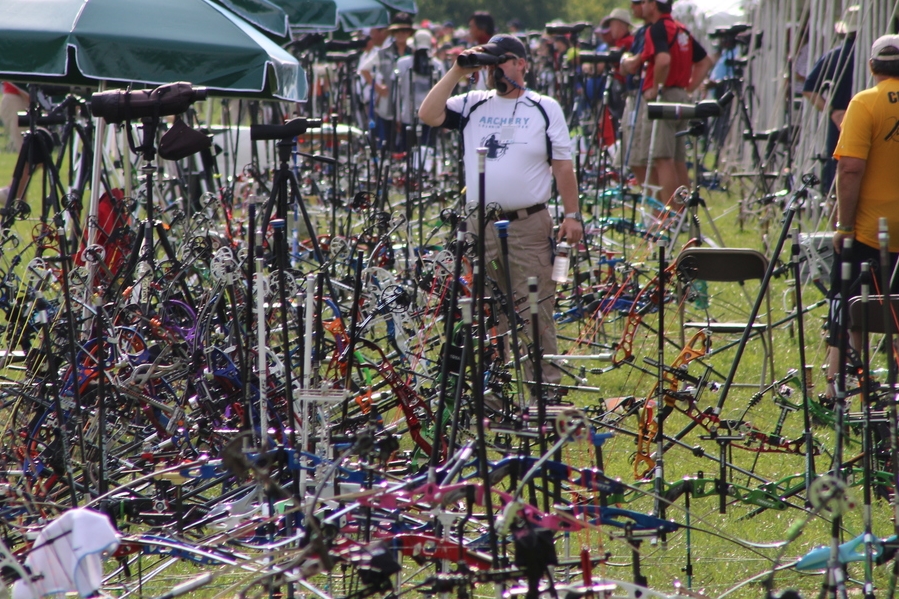
 www.archerylearningcenter.com
www.archerylearningcenter.com

Stabilizers Balance and Bows Oh My! — Archery Learning Center and Proshop
Stabilizers, balance, and bows - oh my! By George Ryals IV © 2010 Stabilizers, over the last decade or so, have become all about vibration damping. Sales of stabilizers and the perceived quality of a stabilizer are measured by how dead it makes the bow feel. Vibration da
The way I select it is by whether it helps me shoot better. And if it does, by how much. Meaning, I start with a barebow - just the sight and quick-disconnects on the bow and that's it, shoot it that way for a while, and that's my baseline. Then I add a little bit of stabilization and observe the results. I repeat that until I find the setup that helps my shooting at the level I'm at. If I go too far (too much stabs and weight) and my shooting starts to deteriorate again, I take stuff off until I get back to that "sweet spot". I stop there and go shoot.I know that for olympic recurve shooters they choose their front stabilizer lengths to be close to their draw length. Is that the same for target compound shooters? I'm struggling to find any explanation on the internet
After about 30 years of experimenting with it, the most optimal setup for me on the target bows I've shot is a single 10" to 12" stab on the front with 2-3oz of weight on it.
Which is just a fancy way of saying I'm not yet at a shooting level where any more than a simple bow balancer helps my accuracy.
YMMV.
As for what you tend to see on the line at your local target competitions, I'd say about 95% of those setups are that way only because the shooter thinks all those bars are supposed to be on the bow. Or that's what a target rig is just supposed to look like and it's supposed to weigh 10lbs, etc. And they weren't selected through trial-and-error to see if it improves the shooter's shooting. Most of them are struggling much harder just to hold the bow up with all that weight on it, than any benefit they're getting from it at the target.
The other 5% do shoot better with their setups, and they tend to be the ones you see on podiums, winning tournaments, etc.
But that's just my approach to it and my impressions based on what I tend to see. It may be a different perspective for other shooters...
lee.
I think a lot get chosen based on the colors or stickers on them, or the most $.
Joined
·
1,099 Posts
Ask Tim Gillingham….he has 6 stabs on his 3D bow !
Choose the length that lets you lean on it the best. Everything else is adjustable with weights.
Joined
·
12,940 Posts
I have a very scientific approach to the selection of my front stab lengths for both my compounds and recurves [and no, my recurve stab length isn't related to draw length], I use a bar length that allows me to rest the bow/stab on the ground between shots with the grip comfortably in my hand while on the line... EXTREME science involved...
i like my front stab long enough to where I can set the bow down and rest it on the front stab with it still in my hand by my side (if that makes sense)
I have a 30” on the front with 15” on the back. Longer equals less weight for a given amount of leverage on the bow. I have 1 oz on the front and 15 on the back, gives my bow a slight rear weight distribution. It’s really about your personal preference.
Joined
·
2,727 Posts
For indoor blue face I use the length that lets me rest the bow on it without me having to lean forwards to balance it. I see lots of people taller than me with shorter bars and it looks uncomfortable.
The only way to be sure is to try them. Here are some thoughts.
Longer stabs can be more stable in perfect conditions, but also more difficult to control. Therefore a longer stab may actually be worse outside where there is even light wind.
I used to pull exactly 30" and shot with a 33" long rod. I found it noticeably better than a 30" long rod. However, this last winter I reduced my draw down to what is now 29 3/8" and made a whole bunch of other changes. I completely rebuilt my shot. All of a sudden, a 30" long rod is better for me than 33"! I find my target acquisition is better and control is easier. Pin float is also a little smoother in outdoor conditions and it all feels a little less hard work. There is a chance I will go back to 33" indoors this winter, but for now I am loving the 30" bar.
Longer stabs can be more stable in perfect conditions, but also more difficult to control. Therefore a longer stab may actually be worse outside where there is even light wind.
I used to pull exactly 30" and shot with a 33" long rod. I found it noticeably better than a 30" long rod. However, this last winter I reduced my draw down to what is now 29 3/8" and made a whole bunch of other changes. I completely rebuilt my shot. All of a sudden, a 30" long rod is better for me than 33"! I find my target acquisition is better and control is easier. Pin float is also a little smoother in outdoor conditions and it all feels a little less hard work. There is a chance I will go back to 33" indoors this winter, but for now I am loving the 30" bar.
Joined
·
38,240 Posts
Great read, yes, but it doesn't answer the Poster's question...........Old but still a good read.

Stabilizers Balance and Bows Oh My! — Archery Learning Center and Proshop
Stabilizers, balance, and bows - oh my! By George Ryals IV © 2010 Stabilizers, over the last decade or so, have become all about vibration damping. Sales of stabilizers and the perceived quality of a stabilizer are measured by how dead it makes the bow feel. Vibration dawww.archerylearningcenter.com
Joined
·
38,240 Posts
Tim is known to try just about anything. Still, most all pictures show Tim with 3 stabs. Here, his back stabs are nearly as long as other's front stabs......Ask Tim Gillingham….he has 6 stabs on his 3D bow !
Joined
·
54,869 Posts
No. Not correct.I know that for olympic recurve shooters they choose their front stabilizer lengths to be close to their draw length.
Olympic recurve shooter. One of the best of all time. Park Sung Hyun.
Front stabilizer, and front extender and v-bar mount....the front stab system is WAY longer
than her recurve draw length.
Joined
·
54,869 Posts
LONGER front stick (stabilizer) will allow you to use LESS weight, to get the same stabilizer power (moment of inertia)...I know that for olympic recurve shooters they choose their front stabilizer lengths to be close to their draw length. Is that the same for target compound shooters? I'm struggling to find any explanation on the internet
ASSUMING that you have perfect stiffness.
See, the LONGER the front stick gets, the more potential for that front stabilizer to be wobbly, to be bendy.
If your front stick is not stiff enough, you lose stabilizer power (stabilizer effectiveness for resistance to movement from original position).
This is why a front stabilizer is available in different grades of carbon...24 ton carbon fiber, 40 ton carbon fiber.
This means a 3/4-inch outside diameter front stab with 24 ton CF
versus
a 3/4-inch outside diameter front stab with 40 ton CF...the 40 ton carbon fiber stabilizer will be much STIFFER (less bendy, less floppy) than the 24 ton carbon fiber stabilizer.
What length TORQUE wrench do I need?
Do I get the 6-inch long wrench handle?
Do I get the 12-inch long wrench handle?
DO I get the 18-inch long cheater bar?
DO I get the 24-inch long cheater bar/torque wrench?
Same concept. IF you have a 6-inch long front stab, and you put 16 ounces of weight on the end,
still pretty easy to wave/wag your bow left to right and left to right. Less resistance to torque your riser left to right again and again.
So, you try the 24-inch long front stab, the most expensive you can afford, with the high-modulus carbon fiber.
This means REALLY stiff and also smaller outside diameter. So, you put the 16 ounces of weight on the end of the
24-inch long front stab, and now you try to wave/wag your bow left to right and left to right again and again.
NEAR impossible to do, cuz you now have a LOT of moment of inertia with the much LONGER stick in front.
So, what about the 32-inch long front stab, the high-modulus carbon fiber front stick?
The longer the front stick, with the top grade carbon fiber, high-modulus stuff, gets REALLY REALLY expensive.
So, how do ya decide if a 32-inch front stick
or maybe the 30-inch front stick
or maybe the 28-inch front stick?
Depends on the FRONT heaviness balance you want.
Depends on whether you will use a BACK bar (side stabilizer) as well.
Depends on your holding weight.
Huh?
What's HOLDING weight gotta do with anything?
I have a 70 lb draw weight bow, with 90% letoff, so my HOLDING weight is only 10% or about 7 lbs.
IF your holding weight is 7 lbs, then, you want LESS weight on the end of the front stick, and possibly a shorter stick.
A good guideline for CONVENIENCE, is to get a front stick (stab length) that allows you to nock your arrow
at WAIST height (top of your jeans or belt) when the end of the front stab and weights are attached to your bow.
TALLER shooter?
Get a longer front stick. NOW, add however much weight you need at the end of the longer front stick,
to get the GROUP size you are looking for. It's all about FRONT heaviness of the stabilizer system.
SHORTER shooter?
Get a shorter front stick. NOW, add however much weight you need at the end of this shorter front stick
to get the GROUP SIZE you are looking for. It's all about FRONT heaviness of the stabilizer system.
LONGER front stick (stabilizer length, IF it's stiff enough),
you need LESS weight on the end of the LONG front stick, to get LOTS of resistance to sideways movement off the target bullseye. It's similar to TORQUE calculations.
SHORTER front stick (stabilizer length, IF it's stiff enough),
you need MORE weight on the end of the SHORTER front stick, to get the SAME resistance to sideways movement off the target bullseye. AGain, at the most basic match, it's similar to a TORQUE calculation.
Joined
·
54,869 Posts
My stab system, 32-inch front stick and a 2-way side mount (can swing vertical, and can swing horizontal like a door hinge) with 12-inch side rods (WHY 12-inch and not 15-inch?...so I can put MORE weight on the side stick to get the balance I want).I know that for olympic recurve shooters they choose their front stabilizer lengths to be close to their draw length. Is that the same for target compound shooters? I'm struggling to find any explanation on the internet
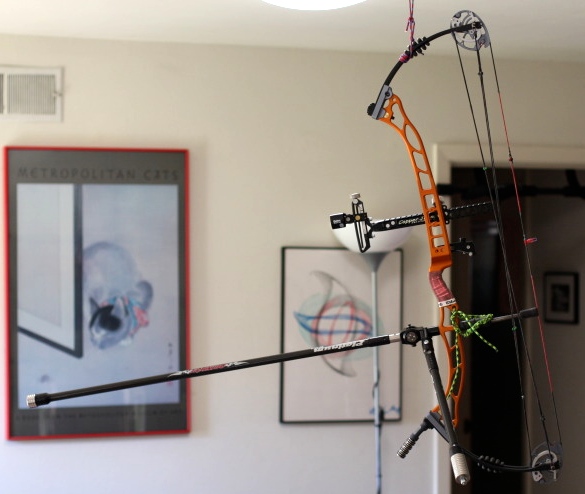
I hung my bow from a hook in the ceiling, just to get a pretty photo.
Hanging the bow from the ceiling is NOT how I arrived at how much weight on the front stick.
Hanging the bow from the ceiling is NOT how I arrived at the vertical down swing angle for the side stick.
Hanging the bow from the ceiling is NOT how I arrived at how much horizontal door swing angle away from the bowstring, for the side stick.
The front stick weight, and the side stick weight, and the horizontal swing angle, and the vertical down swing angle came from hundreds of hours of shooting and testing.
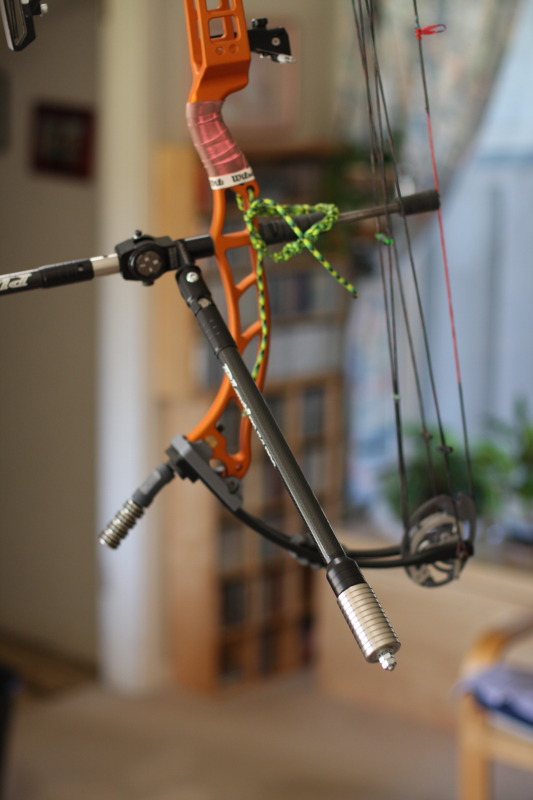
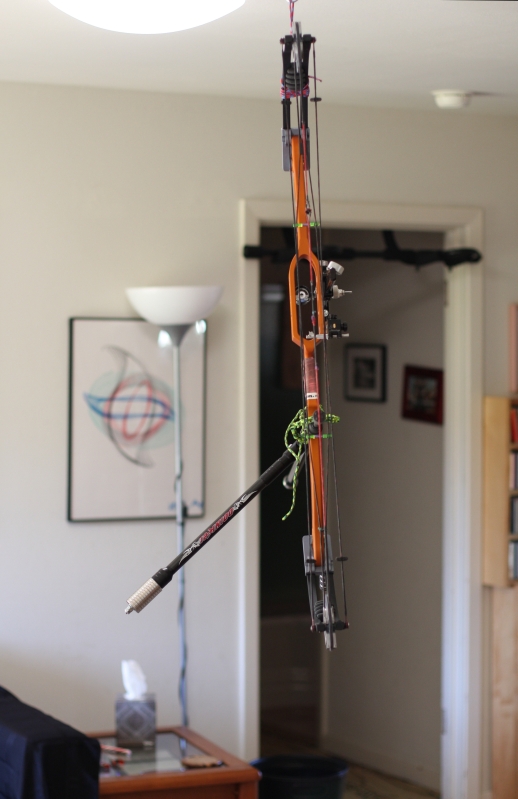
So, with the 32-inch Doinker High Modulus front stab, with weights figured out through lots of shooting testing
and with the 12-inch Doinker Side stab, with weights figured out through lots of shooting testing
I arrive at the perfect amount of front heaviness (front stick weight versus side stick weight)
so I can shoot groups like this at 20 yards.
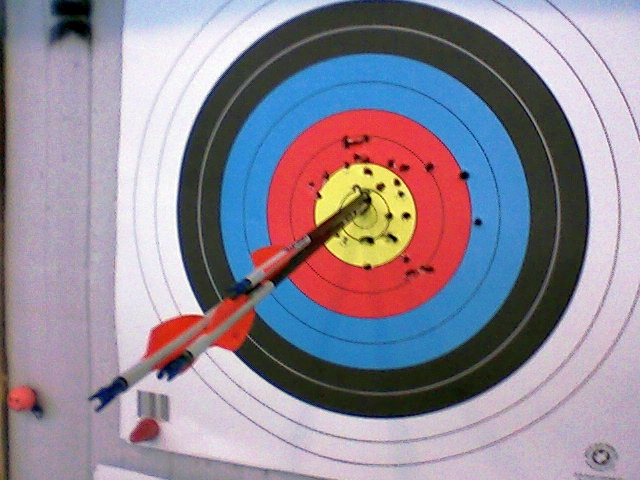
What if I cannot afford all that fancy stuff? What if I can only afford the FRONT stab only?
We all have to start somewhere.
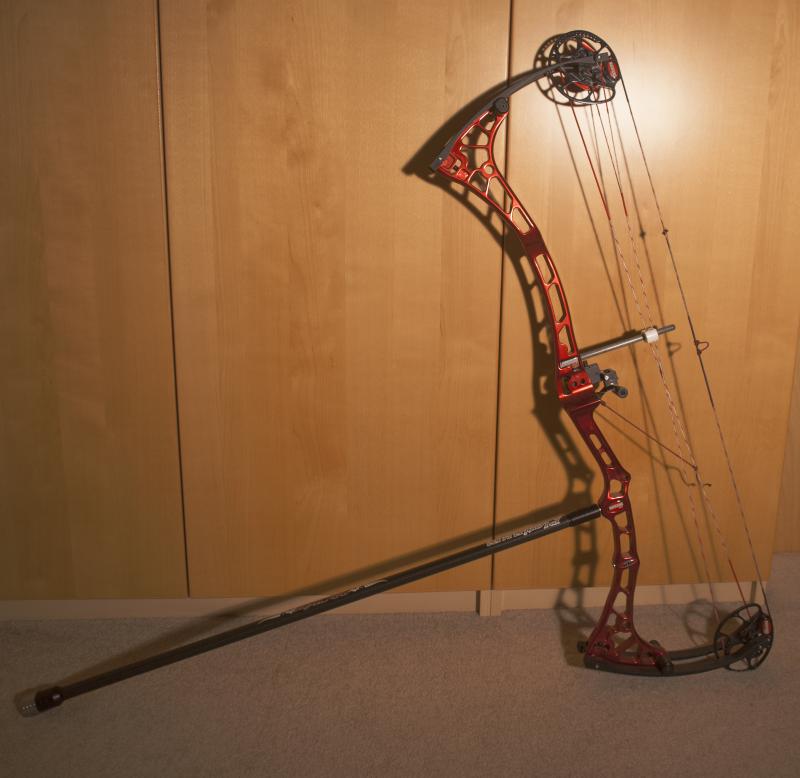
Used target bow.
Maitland Zeus Gen 3. Used off ArcheryTalk.
Just ONE stabilizer, the stick in front. If you cannot afford the fancy stainless stabilizer weights,
then simple fender washers will work just fine.
BUT what length?
Figure out what length front stick, will bring the bowstring (held horizontal) up the top of your belt.
Convenient height to nock an arrow to your bowstring, for a target bow.
THEN, mess with fender washers to find the perfect weight that gives you the tightest groups at 20 yards.
WITH just a front stick only, I get this group size at 20 yards, with the bow IN SPEC.
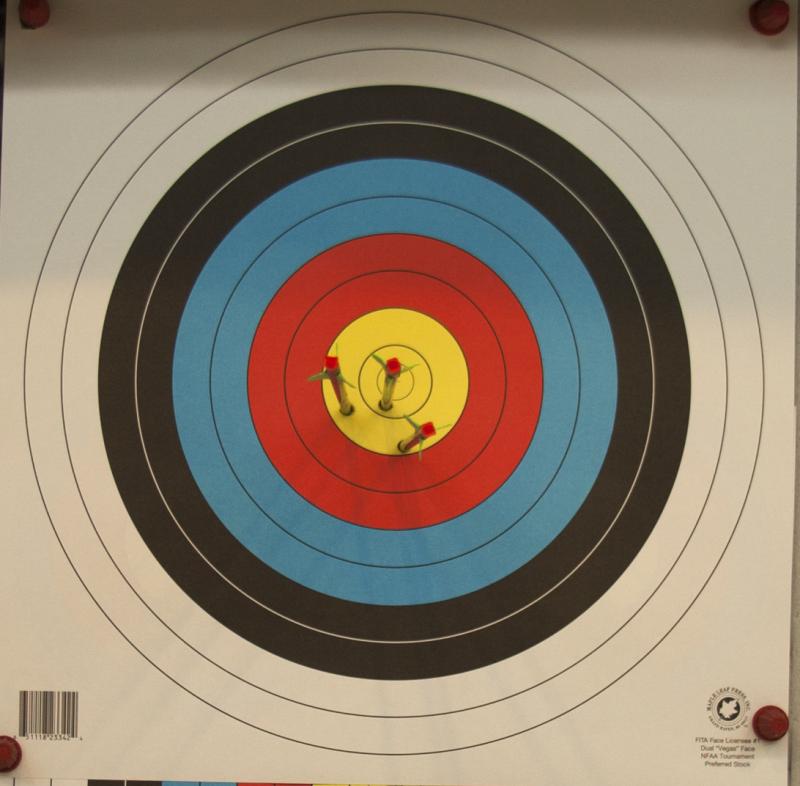
SAME front stabilizer setup, same weight, just a FRONT stick only,
and after tuning the draw length 1/4-inch...IN between module sizes...
I get this group at 20 yards.
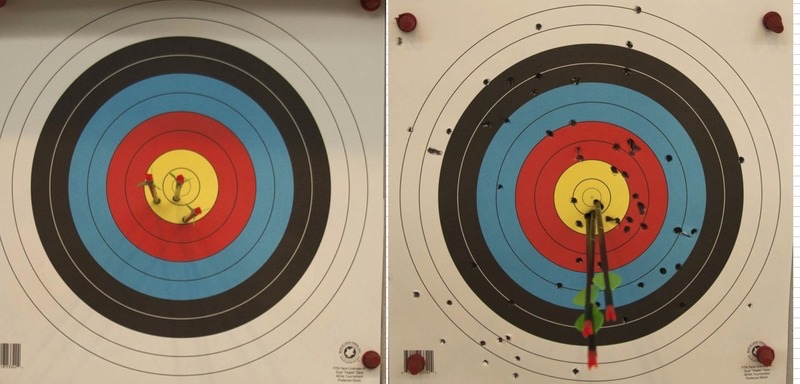
Joined
·
54,869 Posts
Two different bows. EXACT Same Front Stabilizer, with the exact same amount of weight.
Bow on the left is a Maitland Zeus, Gen 3. Old used bow. Company out of business.
Bow on the right is an OK Archery DST 40, with the same 32-inch Doinker Front stick,
and a 12-inch Doinker Side Stick, plus an OK Archery only rubber stalk stab attached to bottom limb bolt plate.
Joined
·
35,186 Posts
Any length will work. It’s honestly what you like/prefer.
I’ve shot 27”, 28”, 30”, 33” and 36”. They all work great. I’ve shot some great scores with everyone of them. If you had the same bar in all of those lengths. Your setup in the end is gonna be different with each one. A few years ago I had a 27/28” B Stinger, a 30” and a 33”. They all worked great. But I ran 17-20oz on the 27”, 7-9oz on the 33” and 10-14oz on the 30”
I usually prefer a 30” which is what the Halcyon I’m running now is.
Sent from my iPhone using Tapatalk
I’ve shot 27”, 28”, 30”, 33” and 36”. They all work great. I’ve shot some great scores with everyone of them. If you had the same bar in all of those lengths. Your setup in the end is gonna be different with each one. A few years ago I had a 27/28” B Stinger, a 30” and a 33”. They all worked great. But I ran 17-20oz on the 27”, 7-9oz on the 33” and 10-14oz on the 30”
I usually prefer a 30” which is what the Halcyon I’m running now is.
Sent from my iPhone using Tapatalk
1 - 20 of 36 Posts
-
?
-
?
-
?
-
?
-
?
-
?
-
?
-
?
-
?
-
?
-
?
-
?
-
?
-
?
-
?
-
?
-
?
-
?
-
?
-
?
- posts
- 39M
- members
- 240K
- Since
- 2001
A forum community dedicated to bow and crossbow owners and archery enthusiasts. Come join the discussion about optics, hunting, performance, troubleshooting, styles, reviews, accessories, classifieds, and more!
Top Contributors this Month
View All
Mossy-Back
765 Replies
King Tut
425 Replies
deadquiet
356 Replies



